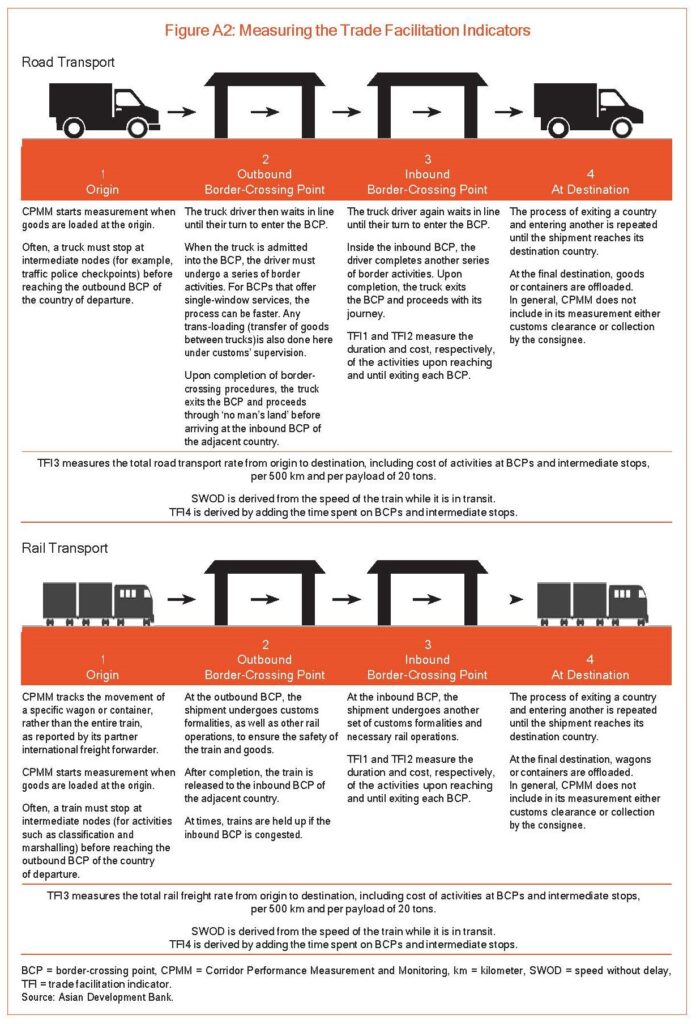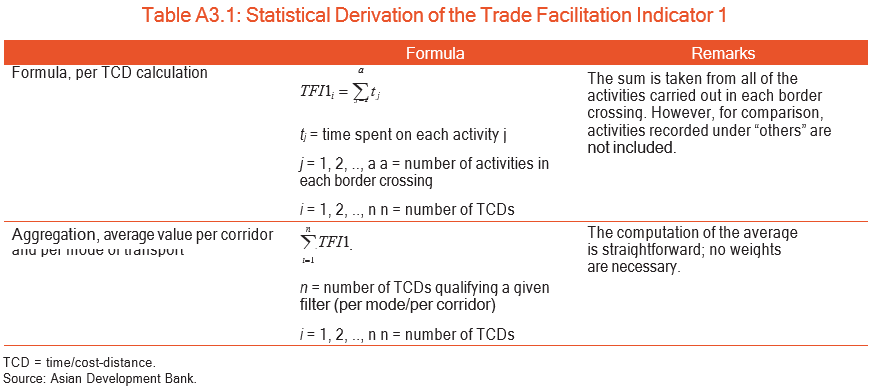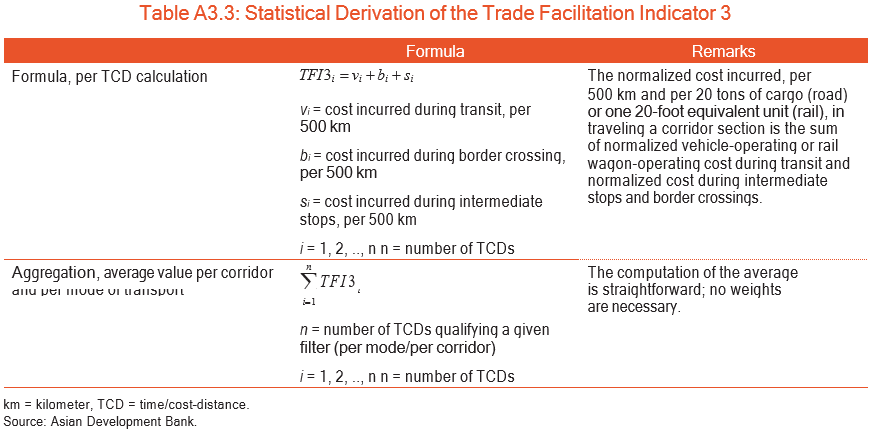Recognizing the pivotal roles of trade facilitation and transport connectivity in the economic growth of the Central Asia Regional Economic Cooperation (CAREC) region, CAREC member countries jointly developed and endorsed the CAREC Transport and Trade Facilitation Strategy (TTFS) in 2007. The TTFS had an integrated approach that centered on the development of six priority CAREC corridors through transport infrastructure investments and trade facilitation initiatives. It also mandated the monitoring and periodic measurement of the performance of the six transport corridors to
- identify the causes of delays and unnecessary costs along the links and nodes of each CAREC corridor, including border-crossing points (BCPs) and intermediate stops;
- help authorities determine how to address the identified bottlenecks; and
- assess the impact of regional cooperation initiatives.
In 2008, the Asian Development Bank (ADB) developed the CAREC Corridors Performance Measurement and Monitoring (CPMM) methodology that offers an accurate and evidence-based foundation for policies aimed at addressing these objectives. The current CPMM methodology is a result of modifications to the original time/cost–distance (TCD) methodology of the United Nations Economic and Social Commission for Asia and the Pacific, which optimized its ability to measure and effectively monitor the border crossing and corridor performance of CAREC corridors over time. The TCD methodology offers an extensive picture of the time and cost dimensions of transport and trade facilitation, particularly regarding border crossings and other impediments along a transit corridor. Aside from time and cost, derived measures such as speed can be used to assess traffic density and road quality. With these factors, several measures and indicators can be developed for the monitoring of border-crossing and customs service efficiency, as well as road and rail infrastructure performance along corridors. When the corridors are monitored regularly, policy makers can easily pinpoint areas that need improvement and financial investment.
With data from TCD-format questionnaires, four trade facilitation indicators (TFIs) are monitored regularly to enable assessment of improvements made in the CAREC corridors. However, unlike other indicators, TFIs are less easy to quantify as they depend on a variety of factors such as (i) the quality and availability of physical infrastructure, (ii) national policies and regulations for transit and trade, (iii) border- crossing procedures, and (iv) the degree of harmonization among countries. Figure A2 illustrates the scope and extent measured in each indicator.
- TFI1: Time taken to clear a BCP. This TFI refers to the average length of time (hours) it takes to move cargo across a border from entry to exit of a BCP. The entry and exit points are typically primary control centers where customs, immigration, and quarantine are handled. Along with the standard clearance formalities, this measurement includes waiting time, unloading or loading time, and time taken to change rail gauges, among other indicators. The intent is to capture both the complexity and the inefficiencies inherent in the border-crossing process.
- TFI2: Costs incurred at a BCP. This is the average total cost, in United States dollars, of moving cargo across a border from entry to exit of a BCP. Both official and unofficial payments are included. This indicator assumes 20 tons of cargo, so that the average costs across various samples are comparable. The CPMM mechanism also analyzes unofficial payments: these are defined as a sum paid on top of that officially recognized by law, with the aim of gaining a favored, preferential treatment in return. No official receipt is given. Tracking an unofficial payment is inherently difficult due to the opaque nature of the transaction.

- TFI3: Costs incurred while traveling along a corridor section. This is the average total costs, in United States dollars, incurred for a unit of cargo traveling along a corridor section within a country or across borders. A “unit of cargo” refers to a cargo truck or train with 20 tons of goods. A “corridor section” is defined as a stretch of road 500 kilometers (km) long. Both official and unofficial payments are included. The TFI3 is the sum of border-crossing cost and vehicle transport cost. Vehicle transport cost is defined as the variable cost component for a shipment: including remuneration for the driver during the shipment; sustenance cost (food and drink, accommodation); fuel cost; parking fees; and minor repairs. The cost components must be specific to the shipment. Nonspecific cost items that are overheads or annual fees such as vehicle tax, insurance, depreciation, and one-time vehicle overhaul are not included in the calculation of vehicle transport cost. In general, the main drivers for this cost are driver remuneration and fuel cost. Many factors can affect vehicle transport cost and, thus, influence the total transport cost. Factors such as distance, weight of cargo, quality of transport infrastructure, number of BCPs, oil price, foreign currency exchange rate, time of year of travel, empty backhaul, market competition, and new legislation can exert a sizable influence on it. All things being equal, vehicle transport cost will be primarily affected by the distance and cargo weight, as this is the basis for the carrier’s quote of the shipment price. In practice due to data collection constraints, transport cost figures reported in CPMM refer to transport rates for trucks, or railway tariffs for trains. “Transport cost” is viewed from the perspective of the shipper and/or receiver. It represents the market rate paid to move the cargo—not the carrier’s cost of providing the service. To standardize transport cost, the CPMM adopts 500 km as a unit of distance, and 20 tons as a unit of weight. This standardized unit enables comparisons to be made between road shipments across different corridors with varying distance and weight.
- TFI4: Speed of travel along a corridor section. This is the average speed, in kilometers per hour (km/h), at which a unit of cargo travels along a corridor section within a country or across borders. Again, a “unit of cargo” refers to a cargo truck or train with 20 tons of goods, and a “corridor section” refers to a stretch of road 500 km long. Speed is calculated by dividing the total distance traveled by the duration of travel. Distance and time measurements include border crossings. The CPMM uses two measures of speed: speed without delay (SWOD) and speed with delay (SWD). SWOD is the ratio of the distance traveled to the time spent by a vehicle in motion between origin and destination (actual traveling time). SWD is the ratio of distance traveled to the total time spent on the journey, including the time the vehicle was in motion and the time it was stationary. Under the CPMM, all activities that cause delays (customs controls, inspections, loading and unloading, and police checkpoints, among others) are recorded by drivers. SWOD represents a measure of the condition of physical infrastructure (such as roads and railways), while SWD is an indicator of the efficiency of BCPs along the corridors.
Statistical Derivation of the Trade Facilitation Indicators
TFI1: Time Taken to Clear a Border-Crossing Point (hour)
This indicator highlights bottlenecks at BCPs, which typically involve lengthy border-crossing procedures and serious delays. Each component activity can be further examined to pinpoint the principal cause of delays (Table A3.1).

TFI2: Costs Incurred at a BCP ($)
This indicator highlights BCPs that have relatively expensive border-crossing procedures, including unofficial payments. Each component activity can be further examined to pinpoint the drivers of cost (Table A3.2).

TFI3: Costs Incurred Traveling Along a Corridor Section ($)
This indicator provides an insight into the cost structure of a corridor and how it compares with those of other corridors. By examining each component, measures can be developed to minimize transit cost (Table A3.3).

TFI4: Speed of Travel Along a Corridor Section (km/h)
Speed indicators provide insights into the level of infrastructure development of CAREC corridors by providing information on the speeds that cargo trucks and trains can attain while traversing specific corridor sections. Under the CPMM, speed is measured by two indicators: SWOD and SWD.
Another factor to consider is the weighting of the observations in the aggregation. As the computed speed represents the transport of the truck or train, speed should be weighted by the tonnage of cargo to represent the weighted average of speed of the cargo itself.
The SWOD (in km/h) is a metric that considers traveling speed only, i.e., when the delivery truck is moving on the road, or when the train is moving on the tracks. When the vehicle or train is stationary, the time is not counted (Table A3.4).

The SWD (in km/h) considers the total time taken for the entire journey, including stoppage time for various reasons (Table A3.5).

